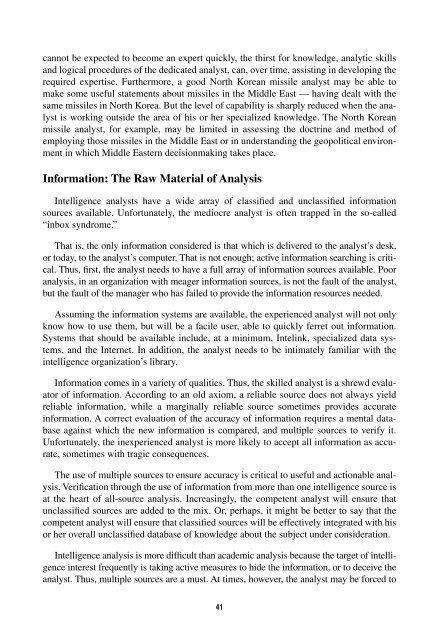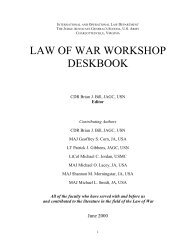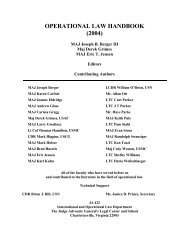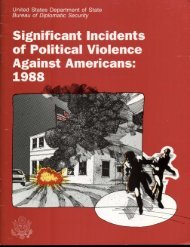learning with professionals - Higgins Counterterrorism Research ...
learning with professionals - Higgins Counterterrorism Research ...
learning with professionals - Higgins Counterterrorism Research ...
You also want an ePaper? Increase the reach of your titles
YUMPU automatically turns print PDFs into web optimized ePapers that Google loves.
cannot be expected to become an expert quickly, the thirst for knowledge, analytic skills<br />
and logical procedures of the dedicated analyst, can, over time, assisting in developing the<br />
required expertise. Furthermore, a good North Korean missile analyst may be able to<br />
make some useful statements about missiles in the Middle East — having dealt <strong>with</strong> the<br />
same missiles in North Korea. But the level of capability is sharply reduced when the analyst<br />
is working outside the area of his or her specialized knowledge. The North Korean<br />
missile analyst, for example, may be limited in assessing the doctrine and method of<br />
employing those missiles in the Middle East or in understanding the geopolitical environment<br />
in which Middle Eastern decisionmaking takes place.<br />
Information: The Raw Material of Analysis<br />
Intelligence analysts have a wide array of classified and unclassified information<br />
sources available. Unfortunately, the mediocre analyst is often trapped in the so-called<br />
“inbox syndrome.”<br />
That is, the only information considered is that which is delivered to the analyst’s desk,<br />
or today, to the analyst’s computer. That is not enough; active information searching is critical.<br />
Thus, first, the analyst needs to have a full array of information sources available. Poor<br />
analysis, in an organization <strong>with</strong> meager information sources, is not the fault of the analyst,<br />
but the fault of the manager who has failed to provide the information resources needed.<br />
Assuming the information systems are available, the experienced analyst will not only<br />
know how to use them, but will be a facile user, able to quickly ferret out information.<br />
Systems that should be available include, at a minimum, Intelink, specialized data systems,<br />
and the Internet. In addition, the analyst needs to be intimately familiar <strong>with</strong> the<br />
intelligence organization’s library.<br />
Information comes in a variety of qualities. Thus, the skilled analyst is a shrewd evaluator<br />
of information. According to an old axiom, a reliable source does not always yield<br />
reliable information, while a marginally reliable source sometimes provides accurate<br />
information. A correct evaluation of the accuracy of information requires a mental database<br />
against which the new information is compared, and multiple sources to verify it.<br />
Unfortunately, the inexperienced analyst is more likely to accept all information as accurate,<br />
sometimes <strong>with</strong> tragic consequences.<br />
The use of multiple sources to ensure accuracy is critical to useful and actionable analysis.<br />
Verification through the use of information from more than one intelligence source is<br />
at the heart of all-source analysis. Increasingly, the competent analyst will ensure that<br />
unclassified sources are added to the mix. Or, perhaps, it might be better to say that the<br />
competent analyst will ensure that classified sources will be effectively integrated <strong>with</strong> his<br />
or her overall unclassified database of knowledge about the subject under consideration.<br />
Intelligence analysis is more difficult than academic analysis because the target of intelligence<br />
interest frequently is taking active measures to hide the information, or to deceive the<br />
analyst. Thus, multiple sources are a must. At times, however, the analyst may be forced to<br />
41

















